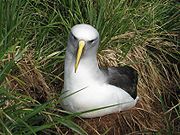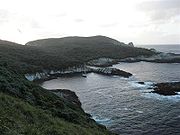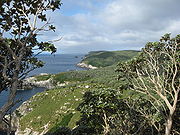
The Snares
Encyclopedia



New Zealand
New Zealand is an island country in the south-western Pacific Ocean comprising two main landmasses and numerous smaller islands. The country is situated some east of Australia across the Tasman Sea, and roughly south of the Pacific island nations of New Caledonia, Fiji, and Tonga...
South Island
South Island
The South Island is the larger of the two major islands of New Zealand, the other being the more populous North Island. It is bordered to the north by Cook Strait, to the west by the Tasman Sea, to the south and east by the Pacific Ocean...
and to the south-south-west of Stewart Island/Rakiura
Stewart Island/Rakiura
Stewart Island/Rakiura is the third-largest island of New Zealand. It lies south of the South Island, across Foveaux Strait. Its permanent population is slightly over 400 people, most of whom live in the settlement of Oban.- History and naming :...
. The Snares consist of the main island North East Island
North East Island, New Zealand
The North East Island is the main island of the Snares Island group at approximately south of New Zealand's South Island. The island forms a central triangle with peninsulas to the north, south and to the west and is some long by wide. Off the South Promontory lies Broughton Island, the second...
and the smaller Broughton Island
Broughton Island, New Zealand
Broughton Island is the second largest island of The Snares, at just off the South Promontory of the main island North East Island, which lies approximately south of New Zealand's South Island. The island is some long in SW direction, and the highest elevation is...
as well as the somewhat isolated Western Chain Islands
Western Chain, New Zealand
The Western Chain is a group of islets at and a part of The Snares. They lie some to the WSW off the main island North East Island, which lies approx. south of New Zealand's South Island...
approx 5 km (3.1 mi) to the WSW. As a group of islands, the Snares cover a total of approximately 3.5 km² (1.35 sq mi).
History
The island group was discovered on 23 November 1791 independently by the two ships HMS DiscoveryHMS Discovery (1789)
HMS Discovery was a Royal Navy ship launched in 1789 and best known as the lead ship in George Vancouver's exploration of the west coast of North America in his famous 1791-1795 expedition. She was converted to a bomb vessel in 1798 and participated in the Battle of Copenhagen. Thereafter she...
under Captain George Vancouver
George Vancouver
Captain George Vancouver RN was an English officer of the British Royal Navy, best known for his 1791-95 expedition, which explored and charted North America's northwestern Pacific Coast regions, including the coasts of contemporary Alaska, British Columbia, Washington and Oregon...
, and HMS Chatham
HMS Chatham (1788)
HMS Chatham was a Royal Navy survey brig that accompanied HMS Discovery on George Vancouver's exploration of the west coast of North America in his 1791–1795 expedition. Chatham was built by King, of Dover and launched in early 1788...
commanded by Lieutenant
Lieutenant
A lieutenant is a junior commissioned officer in many nations' armed forces. Typically, the rank of lieutenant in naval usage, while still a junior officer rank, is senior to the army rank...
William R. Broughton, both of the Vancouver Expedition
Vancouver Expedition
The Vancouver Expedition was a four-and-a-half-year voyage of exploration and diplomacy, commanded by Captain George Vancouver. The expedition circumnavigated the globe, touched five continents and changed the course of history for the indigenous nations and several European empires and their...
. Vancouver named the islands "The Snares" because he considered them a shipping hazard; an islet east of the Western Chain bears the name Vancouver Rock, and the second largest island is named after Broughton. The islands were already known to the Māori, who called one of the larger islands Te Taniwha ("The sea-monster"). Unlike other subantarctic islands that were greatly affected by the whaling
Whaling
Whaling is the hunting of whales mainly for meat and oil. Its earliest forms date to at least 3000 BC. Various coastal communities have long histories of sustenance whaling and harvesting beached whales...
and sealing
Seal hunting
Seal hunting, or sealing, is the personal or commercial hunting of seals. The hunt is currently practiced in five countries: Canada, where most of the world's seal hunting takes place, Namibia, the Danish region of Greenland, Norway and Russia...
industry in the 19th century, the Snares remain one of the last pristine areas in New Zealand.
The Ngai Tahu Claims Settlement Act 1998 officially altered the name to "Snares Islands/Tini Heke" - one of many such changes under the Ngāi Tahu
Ngāi Tahu
Ngāi Tahu, or Kāi Tahu, is the principal Māori iwi of the southern region of New Zealand, with the tribal authority, Te Rūnanga o Ngāi Tahu, being based in Christchurch and Invercargill. The iwi combines three groups, Kāi Tahu itself, and Waitaha and Kāti Mamoe who lived in the South Island prior...
Treaty settlement
Treaty of Waitangi claims and settlements
Treaty of Waitangi claims and settlements have been a significant feature of New Zealand race relations and politics since 1975. Over the last 30 years, New Zealand governments have increasingly provided formal legal and political opportunity for Māori to seek redress for breaches by the Crown of...
.
Environment
The islands provide a home to endemicEndemic (ecology)
Endemism is the ecological state of being unique to a defined geographic location, such as an island, nation or other defined zone, or habitat type; organisms that are indigenous to a place are not endemic to it if they are also found elsewhere. For example, all species of lemur are endemic to the...
bird species such as the Snares Penguin
Snares Penguin
The Snares Penguin , also known as the Snares Crested Penguin and the Snares Islands Penguin, is a penguin from New Zealand...
(Eudyptes robustus), the Snares Snipe
Snares Snipe
The Snares Snipe , also known as the Snares Island Snipe or Tutukiwi in Maori, is a species of bird in the Scolopacidae, or sandpiper family.-Taxonomy and etymology:...
(Coenocorypha huegli) and Snares Tomtit
Tomtit
The Tomtit, Petroica macrocephala, is a small passerine bird in the family Petroicidae, the Australian robins. It is endemic to the islands of New Zealand, ranging across the main islands as well as several of the outlying islands. It has several other English names as well. There are several...
(Petroica macrocephala dannefaerdi), as well as to several endemic invertebrates. North East Island is forested and is the world's premier breeding area for the Sooty Shearwater
Sooty Shearwater
The Sooty Shearwater is a medium-large shearwater in the seabird family Procellariidae. In New Zealand it is also known by its Māori name tītī and as "muttonbird", like its relatives the Wedge-tailed Shearwater and the Australian Short-tailed Shearwater The Sooty Shearwater (Puffinus griseus) is...
(Puffinus griseus) with up to 3 million individuals being present during the breeding season (November-April). A dangerous reef (Seal Reef) lies ten kilometres to the south of the group. Megaherb
Megaherb
Megaherbs are a group of herbaceous perennial wildflowers growing in the New Zealand sub-antarctic islands. They are characterised by their great size, with huge leaves and very large and often unusually-coloured flowers, which have evolved as an adaptation to the harsh weather conditions on the...
communities grow on the islands.
The islands enjoy a status of high protection and are rated as "minimum impact islands". Landing on the islands is generally prohibited or by special research permit only.
The area is among one of five sub-Antarctic island groups forming the New Zealand Sub-Antarctic Islands
New Zealand sub-antarctic islands
The five southernmost groups of the New Zealand Outlying Islands form the New Zealand Sub-Antarctic islands. These islands are collectively designated as an UNESCO World Heritage Site....
, designated as a World Heritage Site
World Heritage Site
A UNESCO World Heritage Site is a place that is listed by the UNESCO as of special cultural or physical significance...
by UNESCO
UNESCO
The United Nations Educational, Scientific and Cultural Organization is a specialized agency of the United Nations...
.
See also
- List of islands of New Zealand
- List of sub-Antarctic islands

